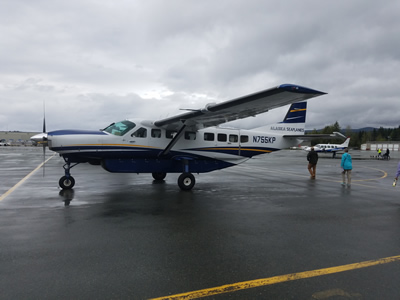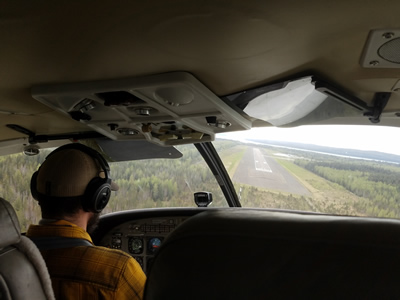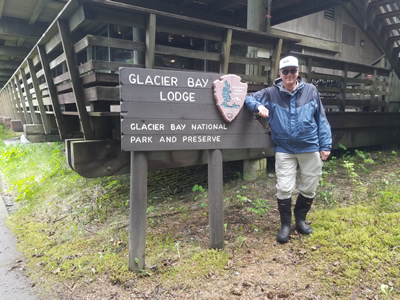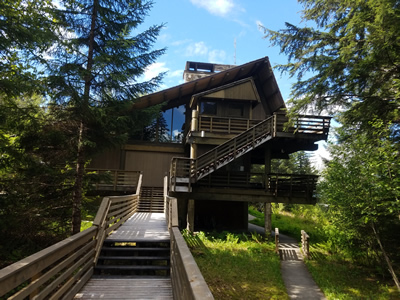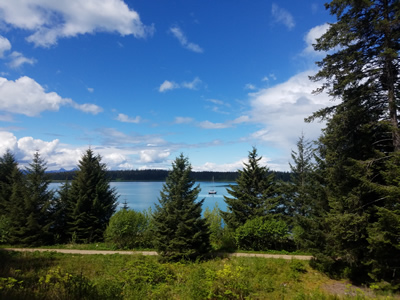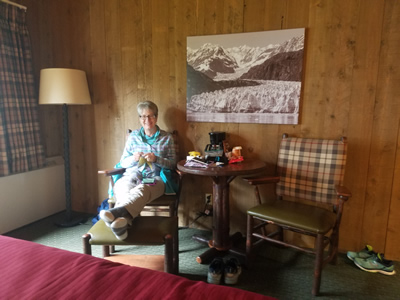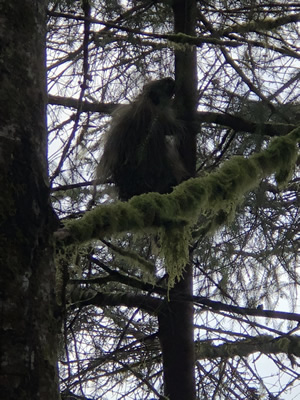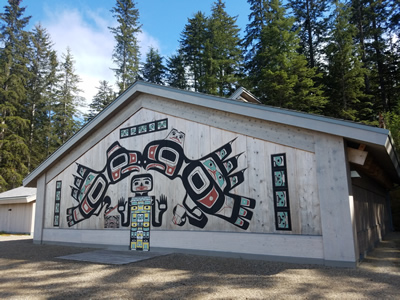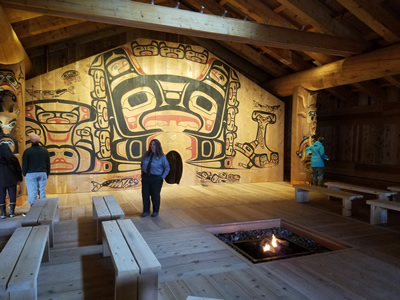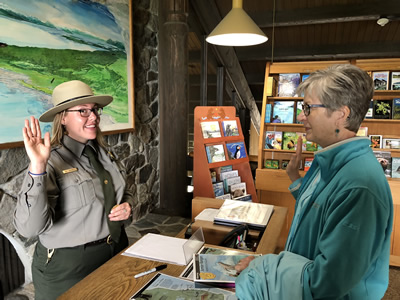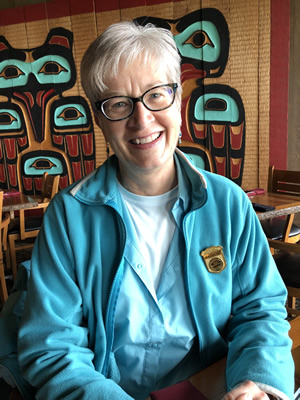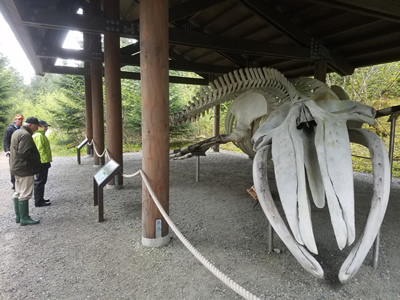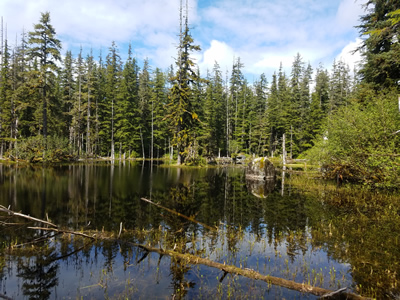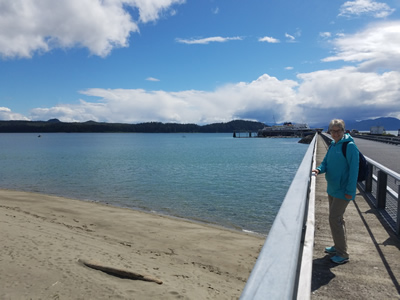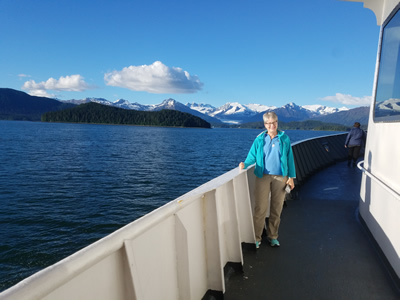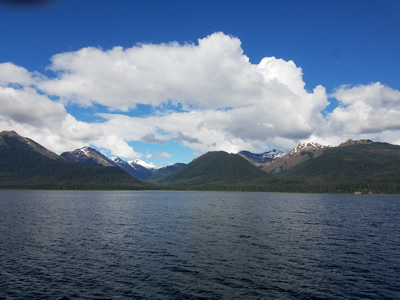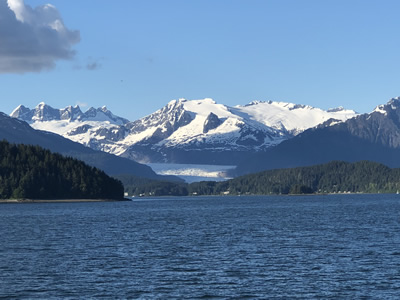Galcier Bay Lodge
We were back in Juneau again.
We had just finished a week long cruise on the Wilderness Adventurer, exploring the area in and around Glacier Bay National Park. When we left it had been warm and sunny. Before our cruise we had done some good hikes in the Juneau area. Now it was cold and rainy, not nice at all. The temperature was about fifty degrees with a harsh wind and a steady rain. Pretty much like a typical winter day in Boise, except that this was the end of May. Welcome to Alaska.
We got off our ship right after breakfast so we had pretty much the whole day. Since the weather was unpleasant we didn't do anything exciting. We spent time looking at the shops, planning what we would get as gifts and souvenirs when we came back again just before going home. We had a long lunch at the Front Street Cafe. The food was good and we were able to watch part of the Milwaukee Brewers - New York Mets game on tv.
The only other people in the bar, also tourists, were watching the game as well. It turned out that they were from New York and were rooting for the other guys. We had a friendly conversation with them though. Fortunately they were good sports because the game ended up being a laugher for the Brewers that they won 17-6.
The next morning it was time to leave Juneau again. Our first week on the cruise had been a complete package with everything included. Now we were going to travel on our own. We were going back to Glacier Bay to stay at the lodge there.
The only way to get to Glacier Bay National Park is by boat or by plane. We started with a flight to Gustavus Alaska on Alaska Seaplanes. We were at the airport more than an hour before our flight to make sure that we had plenty of time. We needn't have worried. After checking in we sat in a waiting area. There were only three other passengers. One guy was going to Sitka. Apparently he would have that flight all to himself. Two young women were going to Gustavus on the same flight that we were.
About ten minutes before our flight was scheduled to leave, a guy walked up and said "anyone going to Gustavus?" The four of us got up and followed him out to our plane, a Cessna 208B Grand Caravan. He climbed into the pilot seat while the rest of us got in the back. With enough seats for nine passengers, there was plenty of space and Sandy and I sat in the first row, just behind the pilot. Pretty soon the pilot had completed his preflight checks and we were rolling down the runway and lifting into the air for the twenty five minute flight to Gustavus.
When we took off I noticed that there was a large lake next to the runway at the Juneau airport. Long and thin, it had a line of docks for seaplanes. Only in Alaska would an airport have a special area for sea planes to land and take off.
I was hoping for great views. I figured that since we were flying by light plane it would be almost as good as an expensive scenic flight. Unfortunately there was a heavy overcast and the big mountains were hidden in clouds. As it was I was just happy that our flight wasn't cancelled.
I did get to see what a lot of the terrain looked like between Juneau and Gustavus. At one point I noticed what at first I thought was a strange avalanche track. Then when I saw that it didn't follow the slope the way it should I realized that it was a clearcut. Then I saw more of them. Even here, where I thought that we were in remote wilderness, there were a lot of ugly clearcuts.
There wasn't much to the Gustavus airport. It has two paved runways at right angles to each other. The runways are paved and quite long for such a small airport. Amazingly enough, during peak summer season, Alaska Airlines operates a daily Boeing 737 flight from Juneau. Seems like overkill for a forty mile flight and I don't know where they put all those people in Gustavus. There was a tiny terminal building, about the size of a small house. It wasn't even clear if it was open or if there was anything inside.
It didn't matter because a van from Glacier Bay Lodge was there waiting for us - I had called ahead to ask for a pickup. The two women on our flight didn't have transportation arranged. Our van driver offered them a lift but they declined saying that they would figure something out.
It turned out that our driver (I think his name was Derek) was from Queensland in Australia. Since Sandy and I have been to Australia multiple times, we spent most of the fifteen minute drive to the lodge talking about Australia rather than Alaska.
Gustavus is pretty small and remote. It has less than five hundred full time residents, although that number increases during the summer months. "Downtown" is at the only four way intersection and has just a handful of buildings scattered around: a gas station, a cafe, a liquor store, a bank, a market and a motel. Not only is the town small but it is quite spread out so I don't think I ever saw two buildings standing next to each other.
It's not easy to get to Gustavus. There is no road access. There is an airport and several local airlines fly light planes in all year. The Alaska Marine Highway System provides ferry service. Once a week a ferry arrives from Juneau and then conitinues on to Hoonah, a small town on Chichigof Island. The next day it goes back the other way, from Hoonah to Gustavus to Juneau. The town's main claim to fame is as the gateway to Glacier Bay. It's surrounded on three sides by the park and on the fourth side by the waters of Icy Strait.
Glacier Bay National Park and Preserve is huge. It covers 3.2 million acres, or just a little over five thousand square miles. That makes it about the size of Connecticut and larger than Rhode Island and Delaware combined. Most of the park, over 2.7 million acres, is designated Wilderness. Together with Wrangell-St. Elias National Park in the US and Kluane National Park and Tatsheshini-Alsek Provincial Park in Canada, it forms a contiguous wilderness of almost 25 million acres. The combined parks have been designated a UNESCO World Heritage Site which is one of the largest protected areas in the world (and may also have the longest name of any park complex in the world).
In spite of its large size, there is almost no development in Glacier Bay National Park. The only facilities are located at Bartlett Cove and include a boat dock, a campground with thirty three sites, the native american Huna Tribal House, and the place where we would be staying, Glacier Bay Lodge. A single road connects to Gustavus, only eight miles away, with its airport and ferry dock.
I didn't know much about Glacier Bay Lodge when I was planning our trip. I only knew that it was quite remote and was the only lodging in the park. Other lodges that we have stayed at in national parks have been pretty cool. Usually they are beautiful, rustic buildings in prime locations for enjoying the park. I figured that since we were exploring on this trip we would give it a try.
And when we got there, sure enough, the main lodge was in a beautiful, rustic building. Built in 1966, it was near the water but in the trees, blending in with its surroundings rather than standing out. It had a small lobby but with a large stone fireplace. There was also a dining area, which was a good thing since there was nowhere else to eat within ten miles. There were only about ten tables inside next to a full wall of windows facing the water - the lodge wasn't very big. There were a few more tables outside on the patio, which would have been nice but the whole time we were there I only saw one couple that was tough enough to eat outside. We were in Alaska after all.
There was also a reception desk and a gift shop (tshirts!!! baseball caps!!!). Upstairs was the National Park Service visitor center. It didn't even have its own building. All of the guest rooms were in seperate buildings. They were connected to the main lodge by a series of raised wooden boardwalks. There were four or five guest buildings, each with about half a dozen rooms. As I said before, the lodge wasn't very big. It was a good thing that I had made our reservations well in advance.
Inside the guest rooms all had the same rustic, mountain lodge feel to them as the main building. They were very nice and it definitely looked like we were going to be comfortable. We might be in the wilderness but we weren't going to be roughing it.
Arriving early on Sunday morning, we had almost three full days and three nights before we would take the ferry back to Juneau. We didn't really have set plans for out time at the lodge, so I didn't know if we would be busy day and night or just relaxing and enjoying being in such a remote place.
There are about ten miles of trail in the area around the lodge. Most are short, only about a mile each, that run along the shoreline of Bartlett Cove, follow the Bartlett River or loop through the rainforest. Two longer trails take different routes to Bartlett Lake and are about ten miles round trip. Those are the only maintained trails in the five thousand square miles of Glacier Bay National Park.
We had a preview the week before while we were on our cruise. We stopped in Bartlett Cove for two hours. That was the limit of the dock time that the Park Service allowed us. It gave us a chance to do some of the short trails. We went part of the way up the Bartlett River trail but turned around when another group came back telling us they had seen a bear near the trail. We also did the forest loop. It was one of only two times on the cruise that we were actually hiking on trails so we tried to make the most of it.
We also picked up a park ranger. Since most of the visitors to the park come on cruise ships, the National Park Service offers to send rangers along on the ships. The big ships send launches to pick up the rangers but our smaller ship was able to fit at the park dock. Besides providing interpretive programs onboard in the evening (and in our case, hiking with us during the day), it probably gives the Park Service a chance to have someone monitor the cruise ships that visit the park for compliance with regulations.
There were always about half a dozen small boats anchored in Bartlett Cove too. A few people come to visit the park on their own boats and have to stop in Bartlett Cove to pick up permits for the park. Other than cruise ships and small boats, the only other visitors to the park were people staying at Glacier Bay Lodge like us or in nearby Gustavus. Of the half a million visitors to the park each year, nearly all of them come on cruise ships. But we had already done that the week before and were back to explore it on land.
Since Sandy and I are hikers we definitly wanted to walk the trails. Being in serious bear country, the first thing we did after checking in at the lodge was to go to the gift shop and buy bear spray. We weren't really that worried. The only fatal bear attack in Glacier Bay National Park was in 1976 (that was a long time ago) but we did want to take all reasonable precautions to make sure that we were safe. We didn't want to be the ones who broke the park's long streak without an incident.
The first day we walked along the shoreline and then continued about a mile on the Bartlett River Trail. It leads to the Bartlett Lake Trail which we wanted to reconnoiter to decide if we would do it the next day. It was pleasant hiking in the forest but there were certainly no views. We went as far as the trail junction before turning around. We decided that we weren't going to come back to hike all the way to the lake. In the dense rainforest visibility was very limited. Although we were making a lot of noise as we hiked, we didn't like the possibility of coming upon a bear suddenly at close range. Since the map showed that the lake was deep in the woods, we didn't expect any expansive views there anyway. Instead of a long trip to a remote lake, we decided to limit our hiking to near the lodge where there were more people. Where there was more activity there would hopefully be fewer bears.
Although we spent a couple of hours walking every day we never did see a bear, close up or far away. The only wildlife we did see were porcupines, which we saw twice (although it might have been the same little guy both times). Once one was right next to the boardwark as we were going to the main lodge from our room. Another time we saw one near the trail along the water. Both times the porcupine climbed into a tree as soon as we got close.
Once we decided that it was going to be a relaxed visit there were still a lot of things for us to do. Although we didn't do any really long hikes we still did quite a bit of hiking, walking along the shore of Bartlett Cove and usually walking the Forest Loop twice a day. On the forest walks we were looking at small things rather than big scenery so we found something new every time that we did the trail. We got pretty good at identifying the different types of fungus that grew in the rainforest.
Near the lodge there was an exhibit that featured the reassembled skeleton of a forty five foot humpback whale known as "Snow". The whale was killed in 2001 when it was struck by a cruise ship. It took two and a half years to prepare her skeleton and build a pavilion where it could be displayed. Although I've seen whales in the wild many times, even up close, in the water you can't really see the whole animal. Here it was possible to see just how big a whale really is. It was definitely impressive.
Also near the lodge was the Huna Tribal House, which is important to the native people in the area who are known as the Tlingit. (Although spelled "tl" whenever the rangers said the name it sounded more like "kl" so it always seemed to us like they were saying "Klingon".) They used to live in the valley that is now Glacier Bay. About two hundred and fifty years ago the glaciers advanced, filling the valley and driving the people out of their homeland. They fled to nearby Chichagof Island and today their descendents still live in the village of Hoonah.
The park service worked with the Tlingit clans to build a tribal house in Bartlett Cove, the first permanent one in Glacier Bay since they were driven out by the glacier. It's a beautiful cedar building decorated with elaborate carvings. Outside it is flanked by two large totems. One afternoon we went to an interesting presentation by one of the rangers at the tribal house. She was a full-blooded Tlingit who had grown up in Hoonah so she was well versed in the traditions, history and legends of the local peoples.
Unlike most national parks that we've visited there isn't a large building for the visitor center. The park service has just set up in the main lodge building, upstairs from the lobby. There was a small bookshop there where Sandy bought a couple of interesting books on Alaska. One that I read after she finished was The Blue Bear by Lynn Schooler and I really enjoyed it. She has a couple more that I haven't got to yet but she says they are good too. I always like reading about the areas that we visit.
There was also a small theater in the visitor center where we watched a different movie about the park every day. There was also a ranger on duty for most of the day to answer questions and every afternoon they would do a guided hike on the forest loop. One day we went along which was interesting as she pointed out a lot of different things than our uncruise guide had the week before.
We also did a special study program. On the cruise, we noticed that quite a few of the crew members wore a badge that said "Junior Park Ranger". When we asked them about it, we were told that you could get them from the rangers in Bartlett Cove. We definitely wanted our own so as soon as we got to the visitor center we asked about them. We were told that they weren't just given away - they had to be earned. We were each given a Junior Ranger workbook to complete. Although designed for kids, they were quite a bit of work. It took me well over an hour to finish mine. Sandy did one too (in fact she got hers done first). Then we had to take them to Ranger Caty to have our work checked. She was the one who had developed the workbooks, including all the art work, so she took it seriously. It actually was really well done. Fortunately both Sandy and I passed. After taking the Junior Ranger Pledge, we were given our badges. Woohoo!
So while we didn't do any heavy duty hiking, we had a pleasant three days at a remote mountain lodge. It actually has a very short season. It's only open from the end of May through early September - barely over three months. In fact it wasn't even open when we stopped there during our cruise. When we arrived for our stay it was only the third day that it was open, so there was hardly anyone there. We had the place to ourselves. The next day the weekly ferry arrived from Juneau and a lot of people came over on that. Still it wasn't bad because the lodge is not very big. Overall we had a nice time there.
My only disappointment, and it was a small one, was the weather. We had some sunny days at the lodge but the big mountains always stayed hidden in the clouds. I was hoping to get a good view of the Fairweather Range, which culminates in 15, 325 foot Mt. Fairweather, but the big snow peaks never came out. I guess you can't have everything. Maybe I'll see them next time.
When our time was up we took the ferry back to Juneau. It actually worked quite well. It left right on time. It took about four hours for the trip. It was a beautiful day and we had tremendous views. We even got to see a lot of wildlife. Just before we left I was on deck and saw a sea lion within fifty feet of the ferry. All through the trip we saw sea otters and sea lions and whales in the water, both close up and in the distance. At one point there was a pod of whales that were breaching quite close to the ferry. There were several small boats loaded with people, probably whale watching tours. We got as good a view as they did. In fact, we saw as much wildlife that afternoon as we did the whole week on the uncruise. Not because of anything special anyone did or didn't do. Seeing wildlife is mostly just a matter of luck.
Our only difficulty came when we landed. The ferry terminal is thirteen miles north of town and we had to wait a long time after we called for a taxi to come out and get us. But we did eventually get a ride back to our hotel, where we checked in for the third and last time on the trip. Our travels on our own had worked out ok. Now we had one day left in Juneau before we had to head home.
